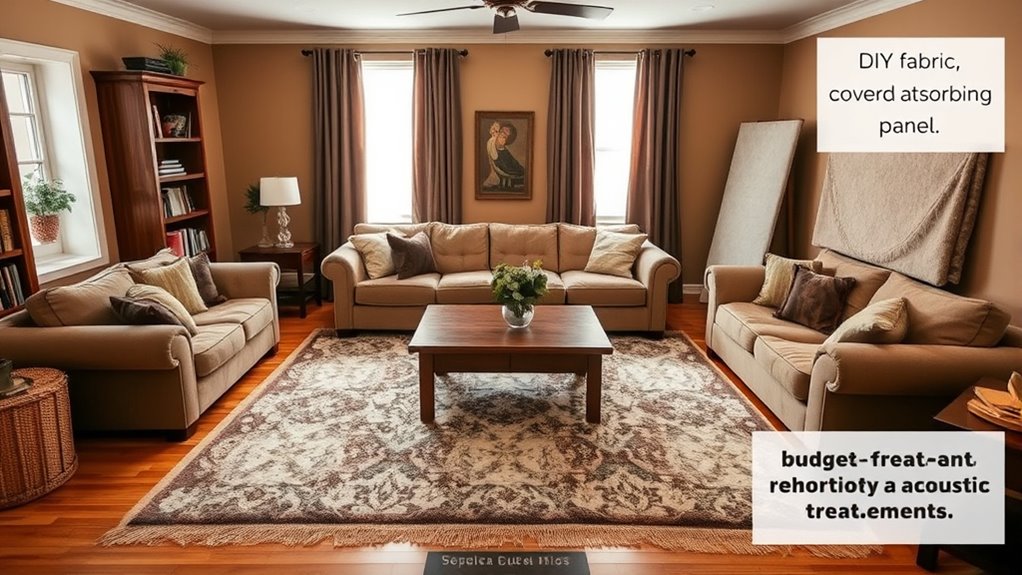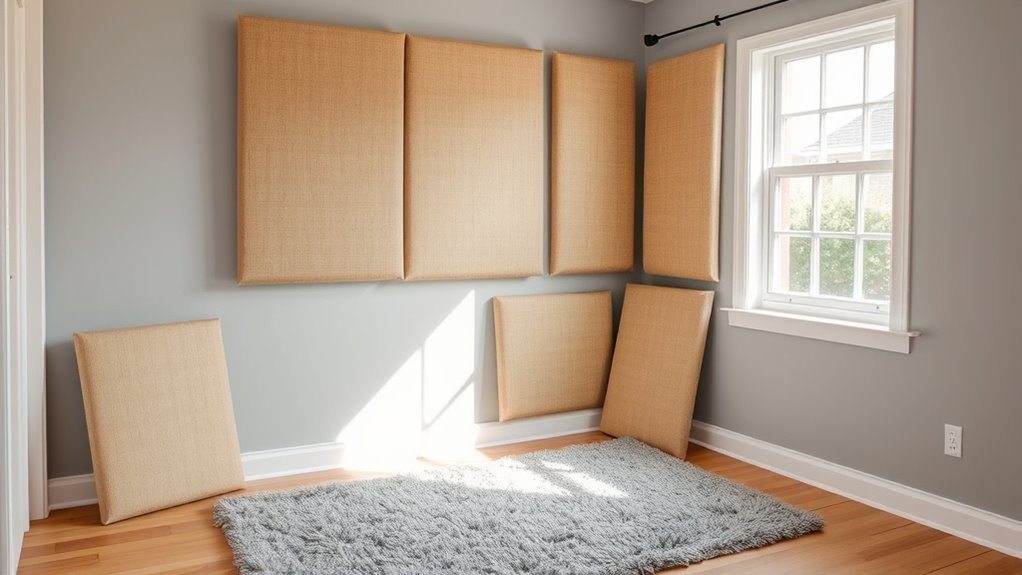To treat your room on a budget, start by strategically placing furniture against walls to absorb sound and break reflections. Use DIY acoustic panels made from thick blankets or fabric hung over windows and doorways. Incorporate household items like plush rugs, cushions, and wall art to further dampen echoes. Using these simple, affordable hacks can considerably improve your space’s acoustics, and if you keep exploring, you’ll find even more clever ways to enhance your sound quality.
Key Takeaways
- Use strategic furniture placement, like placing large pieces against walls, to minimize sound reflections and echo.
- Create DIY acoustic panels with inexpensive materials such as thick blankets or quilted fabric.
- Hang soft household items like curtains, rugs, and plush throws to naturally absorb sound.
- Repurpose household items like stacked boxes filled with fabric or blankets for additional sound absorption.
- Combine furniture arrangement with DIY treatments for an effective, budget-friendly room acoustic upgrade.
Strategic Furniture Placement for Better Acoustics

To improve your room’s acoustics without breaking the bank, start by carefully placing your furniture. Position larger pieces like sofas and bookshelves against walls to absorb sound reflections, which helps reduce echo. Pay attention to wall placement; avoid placing furniture directly in front of reflective surfaces that bounce sound around the room. Instead, stagger or angle furniture to break up sound waves. Additionally, consider window positioning: avoid placing furniture directly in front of or opposite windows, as glass can reflect sound and cause unwanted reverberation. If possible, add soft furnishings near windows to dampen reflections. This strategic furniture placement can considerably improve your room’s acoustics without any extra cost, making your space sound warmer and more inviting. Incorporating sound-absorbing materials such as rugs or curtains can further enhance acoustics naturally and economically.
DIY Acoustic Panels Using Affordable Materials

Creating your own acoustic panels is an effective and budget-friendly way to improve your room’s sound quality. You can craft DIY soundproof curtains from inexpensive materials like thick blankets or quilted fabric to dampen sound reflections and reduce echo. These curtains are easy to hang over windows or doorways, making a noticeable difference without spending much. For bass management, homemade bass traps made from dense foam, mineral wool, or even old mattresses can absorb low-frequency sounds effectively. Building these traps is simple and cost-efficient, requiring minimal tools. Additionally, understanding annuity options can help you plan for long-term financial stability, ensuring your investments support your acoustic improvements and future needs. By combining DIY soundproof curtains and homemade bass traps, you markedly enhance your room’s acoustics without breaking the bank, creating a more balanced and pleasant listening environment.
Creative Solutions With Household Items to Reduce Echo

If you’re looking for quick and cost-effective ways to reduce echo, household items can be surprisingly useful. You can incorporate everyday objects to absorb sound and improve your room’s acoustics. For example, hanging decorative wall art made of soft materials can break up sound waves. Household textiles like thick curtains, plush rugs, and cozy throws help dampen reflections. Placing cushions or fabric-covered furniture around the room also absorbs sound. Additionally, using stacked boxes or storage bins filled with clothes or blankets adds extra sound absorption. These simple solutions not only improve your room’s acoustics but also enhance its visual appeal. With a little creativity, you can turn ordinary household items into effective tools for reducing echo without spending a dime.
Frequently Asked Questions
How Can I Identify the Most Problematic Echo Areas in My Room?
To identify echo hotspots in your room, start by clapping your hands loudly and listen for the sharpness of the sound. Notice where the echo lingers or intensifies—that’s where sound reflection is strongest. You can also record yourself speaking and playback to spot problematic echo areas. These echo hotspots are usually near reflective surfaces like bare walls, windows, or hard floors, which amplify sound reflection and create unwanted reverberation.
What Are the Best DIY Materials for Sound Absorption?
Think of your room as a musical instrument, and sound absorption as tuning it. DIY foam is like a soft pillow for your sound waves, soaking up echoes effectively. Household fabrics—thick curtains, blankets, or upholstery—act as gentle barriers, diffusing sound rather than bouncing it around. Combine these materials for a budget-friendly solution that calms your space, transforming chaos into harmony without breaking the bank.
How Do I Measure the Effectiveness of My Room Treatment?
To gauge your room treatment’s effectiveness, start with sound level testing using a decibel meter to check noise reduction. You can also perform frequency analysis with free software or apps to identify problematic frequencies. By comparing measurements before and after treatment, you’ll see how well your DIY solutions are working. Consistent testing ensures you make targeted improvements, helping you create a better sound environment on a budget.
Can Furniture Placement Impact Sound Quality Without Blocking Outlets?
Did you know that proper furniture arrangement can considerably improve sound quality? You can enhance your room’s acoustics without blocking outlets by strategically placing furniture to reduce echoes and sound reflections. Keep outlet accessibility in mind—avoid blocking outlets with bulky furniture. Instead, use smaller pieces or position furniture to direct sound waves. Thoughtful furniture placement makes a noticeable difference in sound clarity while maintaining easy access to your outlets.
Are There Any Safety Concerns With Using Household Items for Acoustic Treatment?
When using household items for acoustic treatment, safety is key. You should be aware of potential fire hazards, especially with items like foam or fabric that may be flammable. Additionally, consider chemical safety—avoid materials with harmful fumes or chemicals that could cause health issues. Always confirm proper ventilation and keep flammable items away from heat sources. It’s best to use safe, non-toxic materials to protect your home and health.
Conclusion
With a little creativity and some affordable materials, you can transform your room into a cozy haven without breaking the bank. Remember, Rome wasn’t built in a day, and neither is perfect acoustics. By strategically placing furniture, crafting DIY panels, and repurposing household items, you’re well on your way to reducing echo and enhancing sound quality. Stay patient and persistent—your ideal space is just a few clever hacks away.









